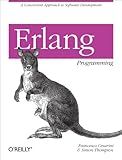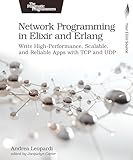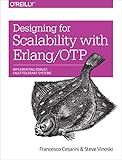Best Erlang OTP Framework Guides to Buy in December 2025

Programming Erlang: Software for a Concurrent World



Erlang Programming: A Concurrent Approach to Software Development



The BEAM Book: Understanding the Erlang Runtime System



Programming Erlang: Software for a Concurrent World



Learn You Some Erlang for Great Good!: A Beginner's Guide
- AFFORDABLE PRICES ON QUALITY USED BOOKS FOR BUDGET-CONSCIOUS READERS.
- RELIABLE DESCRIPTIONS ENSURE GREAT VALUE AND SATISFACTION GUARANTEED.
- ECO-FRIENDLY CHOICE: SUPPORT RECYCLING AND REDUCE WASTE WITH BOOKS.



Network Programming in Elixir and Erlang: Write High-Performance, Scalable, and Reliable Apps with TCP and UDP



Designing for Scalability with Erlang/OTP: Implement Robust, Fault-Tolerant Systems



Erlang: Erlang Programming, In 8 Hours, For Beginners, Learn Coding Fast: Erlang Language, Crash Course Textbook & Exercises


OTP (Open Telecom Platform) is a powerful framework that was developed by the Ericsson company for building fault-tolerant, scalable, and distributed applications in the Erlang programming language. OTP provides a set of design principles, libraries, and tools that can greatly simplify the development process and aid in the creation of reliable and maintainable systems.
To use the OTP framework in Erlang, you need to understand some of the key concepts it introduces:
- Supervision Trees: OTP promotes a hierarchical structure of processes called supervision trees. A supervisor process is responsible for starting, stopping, and monitoring other processes. This hierarchical structure enables automatic recovery from failures and enhances fault tolerance.
- OTP Behaviors: OTP introduces behavior modules that provide generic implementations of common patterns. These behaviors, such as gen_server, gen_fsm, gen_event, etc., define a set of callback functions that you must implement to create your application-specific functionality. They handle messaging, state management, error handling, and other common tasks.
- Application Behavior: OTP provides an application behavior that enables you to manage the lifecycle and dependencies of your application. By creating an application callback module, you can define the start-up and shutdown procedures, as well as specify how your application depends on other applications in terms of start order and application configuration.
- Release Handling: OTP includes a release handling mechanism to facilitate the deployment, upgrade, and management of Erlang applications. You can package your application into a release that includes all necessary components, such as code, modules, configuration files, and resources.
To use OTP in your Erlang application, you typically need to:
- Design the supervision tree structure by defining the supervisors and workers that make up your application.
- Implement your application-specific functionality by creating modules that define the appropriate behavior callbacks.
- Define the application callback module that manages the lifecycle and dependencies of your application.
- Package your application into a release, specifying the necessary dependencies and configurations.
- Start the OTP runtime system, which will automatically start the necessary applications, supervisors, and worker processes according to the defined supervision tree.
By following these steps, you can leverage the power of OTP to build fault-tolerant and scalable Erlang applications efficiently. The framework's well-defined patterns and abstractions allow you to focus on your application's specific logic while benefiting from the robustness and reliability provided by OTP.
What is the purpose of OTP design principles and recommended practices?
The purpose of OTP (Open Telecom Platform) design principles and recommended practices is to provide a framework and guidelines for developing robust, scalable, and maintainable software systems. OTP is a set of libraries, programming conventions, and design patterns that are used for building distributed, concurrent, fault-tolerant, and high-performance applications.
The design principles and recommended practices of OTP aim to address the challenges faced while developing such systems by promoting modularity, code reuse, fault tolerance, and supervision. By following these principles and practices, developers can create systems that are easier to understand, maintain, and evolve over time.
Some key goals of OTP design principles and recommended practices include:
- Modularity: Breaking down complex systems into smaller, independent, and reusable components to enhance code organization, understandability, and testability.
- Concurrency and scalability: Leveraging the actor model of concurrency and the use of lightweight processes to enable efficient utilization of system resources and handling of large numbers of concurrent requests.
- Fault tolerance: Designing systems that can recover from and handle errors gracefully by leveraging supervision trees and error handling mechanisms.
- Hot code swapping: Enabling the ability to upgrade a running system without stopping it, thus minimizing downtime and achieving high availability.
- Testing and debugging: Providing tools and techniques for writing unit tests, property-based tests, and for debugging and profiling applications.
- Documentation and community: Promoting the use of clear and comprehensive code documentation and fostering an active community around the OTP framework for knowledge sharing and support.
By adhering to these principles and practices, developers can build highly reliable systems that are able to handle unpredictable scenarios and scale with the growing demands of modern applications.
What is the purpose of release handling in OTP framework?
The purpose of release handling in the OTP (Open Telecom Platform) framework is to manage the lifecycle of a software release. It involves packaging the application, its dependencies, and system configuration into a release bundle that can be deployed and run in a production environment.
Release handling provides a structured way to bundle and deploy applications, ensuring that all required components are included and properly configured. It also enables consistent and reliable upgrades and rollbacks of the software release.
Additionally, release handling in OTP offers the following benefits:
- Dependency Management: It allows developers to specify and manage dependencies between different components of the application, ensuring that all required dependencies are included in the release bundle.
- Consolidated Configuration: Release handling allows system configuration to be included as part of the release bundle, ensuring that the application is properly configured when deployed in different environments.
- System Upgrades and Rollbacks: It provides mechanisms to upgrade or rollback the software release in a controlled and consistent manner. This helps in deploying new features, bug fixes, or security patches without disrupting the availability of the application.
- System Monitoring and Diagnostics: Release handling in OTP provides tools and APIs for monitoring and diagnosing the running system. It enables logging, debugging, and profiling of the application, aiding in troubleshooting and performance optimization.
In summary, release handling in OTP framework simplifies the deployment, management, and monitoring of software releases, ensuring that applications can be reliably and efficiently deployed in production environments.
How to define and work with gen_statem finite state machines in OTP framework?
In the OTP (Open Telecom Platform) framework, you can define and work with gen_statem finite state machines by following these steps:
- Create a new module for your gen_statem implementation. For example, you can create a module named my_fsm.
- In the module, use the behaviour attribute to specify that you are implementing the gen_statem behavior:
@behaviour gen_statem
- Define the initial state and state-specific callback functions. These callback functions will be triggered when the gen_statem transitions between states, receives events, or needs to handle some other state-related actions. For example:
-module(my_fsm).
@behaviour gen_statem.
-export([ start_link/0, init/1 ]).
-export([ handle_event/3, handle_sync_event/4, handle_info/3, handle_sync_info/4, terminate/3, code_change/4 ]).
-record(state, {}).
init(_Args) -> {ok, state, {}}.
handle_event(_Event, _From, State) -> {next_state, state, State}.
handle_sync_event(_Event, _From, State) -> {reply, ok, state, State}.
handle_info(_Info, State) -> {next_state, state, State}.
handle_sync_info(_Info, State) -> {reply, ok, state, State}.
terminate(_Reason, _State, _Data) -> ok.
code_change(_OldVsn, State, _Extra) -> {ok, state, State}.
Here, we have only defined an initial state called state (can be named differently as per your requirement), and the callback functions for different events and actions.
- Implement the start function that will start the gen_statem process:
start_link() -> gen_statem:start_link({local, ?MODULE}, ?MODULE, [], []).
- You can now start your gen_statem finite state machine by calling the start_link/0 function. This will create a new process and initialize it with the defined callback functions for handling different events and actions:
my_fsm:start_link().
- To interact with the state machine, you can send events using the gen_statem:call/3 or gen_statem:cast/2 functions. For example:
gen_statem:cast(?MODULE, {event, Data}).
Here, cast is an asynchronous call that doesn't expect a reply. You can also use call for synchronous calls that expect a reply.
These steps outline the basic process of defining and working with gen_statem finite state machines in the OTP framework. You can further customize your implementation by adding more states, events, and actions as per your specific requirements.
